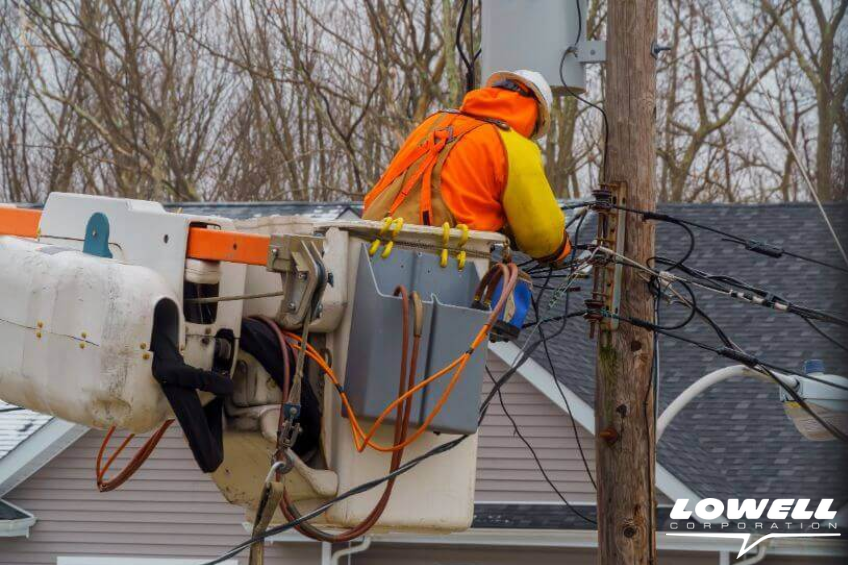How to Become a Power Lineman
Thinking about becoming a power lineman? You’re not alone—and you’re in the right place. Linemen are the backbone of America’s power grid, and getting started in this career means stepping into a field built on skill, grit, and dedication. Whether you’re eyeing your first apprenticeship or looking to sharpen your edge with better training, the journey starts with the right mindset—and the right tools.
At Lowell, we’ve supported linemen since 1869 with dependable American-made wrenches built for life on the line. In this blog, we’ll walk you through the steps to become a power lineman, what qualifications you’ll need, and where to find the training that sets you up for success. If you’re ready to climb, we’re ready to help you gear up.
What We’ll Cover:
- What power linemen do
- Review your qualifications
- Complete the application process
- Schedule your interview
- Join the power lineman rank list
- Conduct a safety orientation and first dispatch
- Begin field training and classroom dispatch
- Assemble your toolkit
- Where to find lineman training resources
- Key takeaways
What Do Power Linemen Do?
The role of an apprentice power lineman is to assist in building and maintaining electrical power systems. One popular route is Northwest Lineman College’s apprenticeship training with lineman tools is a popular training program.
The apprenticeship program at Northwest Line JATC combines supervised, structured, on-the-job training with related classroom instruction. Their goal is to prepare you for skilled employment within the industry.
Keep reading to review the steps to complete the training for a rewarding career as a power lineman.
Step 1: Review Your Qualifications
Being a journeyman lineman isn’t for everyone. Although the job pays well and provides excellent benefits, a lineman often has to work outside in unfriendly weather conditions and climb high poles. It’s not for anyone afraid of heights.
The job involves physically and mentally demanding work. The job can also require a fair amount of travel, which can mean many nights away from home.
Step 2: Complete the Power Lineman Application Process
To apply for the apprenticeship program, you must meet some basic qualifications:
- You must be at least 18 years old
- High school diploma or GED
- A passing grade of “C” or better in Algebra
- Class A CDL (Commercial Driver’s License)
- Ability to operate hand tools, including a strap wrench or square wrench
Although you are not required to have any previous experience with highline tools, any experience or training may allow you to take an accelerated path in your program. Submitting your documentation and your application will allow your program to assess where to place you based on your previous work experience or vocational training.
Step 3: Schedule Your Interview
Once your application is complete, you will need to attend a mandatory orientation that covers the life of an apprentice and journeyman lineman. After attending, you will be interviewed at the JATC office. You will interview the Committee (made up of line contractors and members of the local unions), who will score you based on everything they’ve learned about your background, attitude, and interests.
Step 4: Join the Power Lineman Rank List
Your scores from the interview will form an average. That average places you on the ranking list with all previous applicants who have yet to start the program. So, if you score high, you’ll move right to the top of the list regardless of how long other applicants have been waiting. Applicants who interview in the next cycle will reach the same list in the same manner. Your name will leave the list after two years if you don’t have an indentured status.
Looking for high-quality highline tools? Read our product guide for utility workers.
Step 5: Conduct a Safety Orientation and First Dispatch
Top applicants enter Safety Orientation before their first dispatch. Safety Orientation is mandatory and covers various topics, including proper tool safety, American wrench manufacturers, and the responsibilities of an apprentice. When a contractor needs an apprentice, they call the JATC office. If your name is at the top of the list, you’ll receive a dispatch call with all the information you need to get started.
You are now officially an apprentice lineman. Congratulations!
Step 6: Begin Field Training and Classroom Instruction
After orientation, you’ll join a crew of linemen to gain valuable hands-on training in the field. Each fall, you will resume regular classroom instruction in tool maintenance, electrical theory, circuitry, transformer connections, and more.
Completing the training instruction and becoming a journeyman lineman requires working full-time for nearly four years as an apprentice (around 7,000 hours). During this time, you’ll advance through seven steps of the program. After completing each step, your pay rate will increase, coming closer and closer to that of other journeymen linemen.
To learn all aspects of the trade, most apprentices get to work for more than one contractor during their time in the program.
Step 7: Assemble Your Toolkit
As you prepare to enter the field, building your toolkit is just as important as your training. Every lineman needs a solid set of dependable tools to perform safely and efficiently, starting with the right wrenches. Lowell’s transmission and distribution lineman wrenches are known across the industry for their durability, precision, and performance in the most demanding conditions. With features like our signature Bolt-Thru design, ergonomic grips, and high-visibility epoxy coatings, Lowell tools are built to last and are easy to maintain in the field.
From triple square and double square wrenches to socket sets and speed wrenches, Lowell has everything linemen need to handle a wide range of hardware and installation scenarios. Our tools are engineered in the U.S.A. and backed by reliable customer support and a manufacturer’s warranty, so you can trust they’ll hold up on the job—day in and day out.
Where to Find Lineman Training Resources
Embarking on a career as a power lineman requires not only a strong dedication but also access to the right training resources. These resources provide the necessary knowledge and hands-on experience to safely and efficiently work on electrical power systems. Here are some valuable resources to get you started:
1) Trade Schools and Community Colleges
Many community colleges and vocational schools offer lineman training programs that include both classroom instruction and field training. These programs typically cover electrical theory, safety practices, and specific training on climbing and equipment usage.
2) Lineman Training Centers
Specialized training centers offer comprehensive programs that simulate real-world scenarios. These centers are equipped with the facilities and equipment that allow for practical experience in a controlled environment.
3) Online Courses and Webinars
With the advancement of digital learning platforms, many institutions now offer online courses that can supplement hands-on training. These courses often cover theoretical aspects of the work and are a great way to continue learning remotely.
4) The Lowell Corporation Blog
The Lowell Corporation blog is an invaluable resource for both aspiring and experienced linemen. It provides insights into the latest tools, technologies, and techniques in the industry. Regularly updated, the blog offers practical advice, safety tips, and innovations that can enhance your skills and knowledge in the field.
By leveraging these resources, you can gain a solid foundation and ongoing support throughout your journey to becoming a skilled power lineman.
Key Takeaways
Becoming a power lineman takes more than physical strength—it requires focus, endurance, and a commitment to safety and skill. From meeting apprenticeship requirements to completing hands-on field training, the path is challenging but rewarding. Programs like those offered by Northwest Line JATC provide a strong foundation, while resources like the Lowell blog help linemen stay sharp and informed. With the right tools, mindset, and support, you can build a lasting career in one of the nation’s most essential trades—keeping communities powered and connected every step of the way.
Whether you’re just starting your career or advancing to journeyman status, choosing the right toolkit can make all the difference. With Lowell in your belt, you’re not just prepared—you’re powered by a legacy of American-made quality trusted by linemen for over 150 years.
For more information about the Lowell wrench sets, call (800) 456-9355 or email customerservice@lowellcorp.com. You can also connect with us on Facebook for exciting updates on future products.
Linemen need tough wrenches that can withstand the test of time. Lowell can make your utility work easier.
The Best Power Lineman Tools Since 1869
Lowell Corporation offers the best hand tools in the industry. Whether you need a strap wrench or a square wrench set, you’ll want the right balance between cost and efficiency. Our custom hand tools make tough jobs easier for waterworks engineers and highline workers.
We’ve been increasing construction, maintenance, and manufacturing productivity since 1869. Let our lineman wrench sets simplify your workload. With our essential highline tools, you get the backing of the most trusted name in the hand tool industry.
Lowell Corporation is proud to manufacture all of our lineman tools right here in the USA, in the heart of New England. All Lowell lineman speed wrenches are 100% guaranteed with our one-year manufacturer’s warranty against defects in material and craft for one year from delivery.
Make sure to follow us on Instagram for exciting product updates and promotions!




